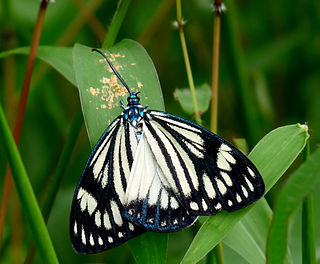
De Havilland Aircraft Company Limited was a British aviation manufacturer established in late 1920 by Geoffrey de Havilland at Stag Lane Aerodrome Edgware on the outskirts of north London. Operations were later moved to Hatfield in Hertfordshire.

The de Havilland DH.82 Tiger Moth is a 1930s British biplane designed by Geoffrey de Havilland and built by the de Havilland Aircraft Company. It was operated by the Royal Air Force (RAF) and many other operators as a primary trainer aircraft. In addition to the type's principal use for ab-initio training, the Second World War saw RAF Tiger Moths operating in other capacities, including maritime surveillance and defensive anti-invasion preparations; some aircraft were even outfitted to function as armed light bombers.

The Pterophoridae or plume moths are a family of Lepidoptera with unusually modified wings. Though they belong to the Apoditrysia like the larger moths and the butterflies, unlike these they are tiny and were formerly included among the assemblage called "microlepidoptera".

The Zygaenidae moths are a family of Lepidoptera. The majority of zygaenids are tropical, but they are nevertheless quite well represented in temperate regions. Some of the 1000 or so species are commonly known as burnet or forester moths, often qualified by the number of spots, although other families also have 'foresters'. They are also sometimes called smoky moths.

The Gelechiidae are a family of moths commonly referred to as twirler moths or gelechiid moths. They are the namesake family of the huge and little-studied superfamily Gelechioidea, and the family's taxonomy has been subject to considerable dispute. These are generally very small moths with narrow, fringed wings. The larvae of most species feed internally on various parts of their host plants, sometimes causing galls. Douglas-fir (Pseudotsuga) is a host plant common to many species of the family, particularly of the genus Chionodes, which as a result is more diverse in North America than usual for Gelechioidea.

Oenosandridae is a family of noctuoid moths in the order Lepidoptera. The members are moths found in Australia. Genera include Diceratucha, Discophlebia, Nycteropa, and Oenosandra.

Castniidae, or castniid moths, is a small family of moths with fewer than 200 species: The majority are Neotropical with some in Australia and a few in south-east Asia. These are medium-sized to very large moths, usually with drab, cryptically-marked forewings and brightly coloured hindwings. They have clubbed antennae and are day flying, and are often mistaken for butterflies. Indeed, some previous classification systems placed this family within the butterflies or skippers. The Neotropical species are commonly known as giant butterfly-moths, the Australian and Asian species as sun moths. The larvae are internal feeders, often on roots of epiphytes or on monocotyledons.

The Moth Class is the name for a small development class of sailing dinghy. Originally a cheap home built sailing boat designed to plane, now it is an expensive largely commercially produced boat designed to hydroplane on foils.

The de Havilland DH.60 Moth is a 1920s British two-seat touring and training aircraft that was developed into a series of aircraft by the de Havilland Aircraft Company.

Nepticulidae is a family of very small moths with a worldwide distribution. They are characterised by eyecaps over the eyes. These pigmy moths or midget moths, as they are commonly known, include the smallest of all living moths, with a wingspan that can be as little as 3 mm in the case of the European pigmy sorrel moth, but more usually 3.5–10 mm. The wings of adult moths are narrow and lanceolate, sometimes with metallic markings, and with the venation very simplified compared to most other moths.
Gymnasura is a genus of moth in the family Erebidae.

Gymnasura semilutea is a moth in the subfamily Arctiinae. It is found in Taiwan and China.

Habrosyne indica is a moth in the family Drepanidae. It is found from India to Taiwan and Japan.
Gymnasura flavia is a moth of the subfamily Arctiinae. It was described by George Hampson in 1900. It is found on New Guinea and in Queensland, Australia.
Gymnasura prionosticha is a moth of the subfamily Arctiinae. It was described by Turner in 1940. It is found in Australia.
Gymnasura costaesignata is a moth of the family Erebidae. It was described by Max Gaede in 1925. It is found in Papua New Guinea.
Gymnasura dentiferoides is a moth of the subfamily Arctiinae. It was described by Rothschild in 1915. It is found in New Guinea.
Gymnasura pallida is a moth of the subfamily Arctiinae. It was described by Rothschild in 1913. It is found in New Guinea.
Gymnasura rhodina is a moth of the subfamily Arctiinae. It was described by Rothschild and Jordan in 1905. It is found in New Guinea.
The Nudariina are a subtribe of lichen moths in the family Erebidae.














